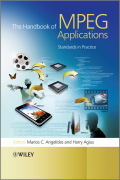
The handbook of MPEG applications: standards in practice
Angelides, Marios C.
Agius, Harry
In this book, the authors address five leading MPEG standards: MPEG-2, MPEG-4, MPEG-7, MPEG-21, and MPEG-A, focusing not only on the standards themselves, but specifically upon their application (e.g. for broadcasting media, personalised advertising and news, multimedia collaboration, digital rights management, resource adaptation, digital home systems, and so on); including MPEG cross-breed applications. In the evolving digital multimedia landscape, this book provides comprehensive coverage of the key MPEG standards used for generation and storage, distribution and dissemination, and delivery of multimedia data to various platforms within a wide variety of application domains. It considers how these MPEG standards may be used, the context of their use, and how supporting and complementary technologies and the standards interact and add value toeach other INDICE: List of Contributors. Chapter 1: MPEG Standards in Practice (Marios C. Angelides and Harry Agius). 1.1 MPEG-2. 1.2 MPEG-4. 1.3 H.264/AVC/MPEG-4 Part 10. 1.4 MPEG-7. 1.5 MPEG-21. 1.6 MPEG-A. 1.7 Chapter Summaries. References. Chapter 2: HD Video Remote Collaboration Application (Beomjoo Seo, Xiaomin Liu and Roger Zimmermann). 2.1 Introduction. 2.2 Design and Architecture. 2.3 HD Video Acquisition. 2.4 Network and Topology Considerations. 2.5 Real-time Transcoding. 2.6 HD Video Rendering. 2.7 Other Challenges. 2.8 Other HD Streaming Systems. 2.9 Conclusions and Future Directions. References. Chapter 3: MPEGStandards in Media Production, Broadcasting and Content Management (Andreas Mauthe and Peter Thomas). 3.1 Introduction. 3.2 Content in Context of Production and Management. 3.3 MPEG Encoding Standards in CMS and Media Production. 3.4MPEG-7 and Beyond. 3.5 Conclusions. References. Chapter 4: Quality Assessmentof MPEG-4 Compressed Videos (Anush K. Moorthy and Alan C. Bovik). 4.1 Introduction. 4.2 Previous Work. 4.3 Quality Assessment of MPEG-4 Compressed Video. 4.4 MPEG-4 Compressed Videos in Wireless Environments. 4.5 Conclusion. References. Chapter 5: Exploiting MPEG-4 Capabilities for Personalized Advertising in Digital TV (Martín López-Nores, Yolanda Blanco-Fernández, Alberto Gil-Solla, Manuel Ramos-Cabrer and José J. Pazos-Arias). 5.1 Introduction. 5.2 Related Work. 5.3 Enabling the New Advertising Model. 5.4 An Example. 5.5 Experimental Evaluation. 5.6 Conclusions. References. Chapter 6: Using MPEG tools in video summarization (Luis Herranz and José M. Martínez). 6.1.Introduction. 6.2 RelatedWork. 6.3 A Summarization Framework using MPEG Standards. 6.4 Generation of Summaries using MPEG-4 AVC. 6.5 Description of Summaries in MPEG-7. 6.6 Integrated Summarization and Adaptation Framework in MPEG-4 SVC. 6.7 Experimental Evaluation. 6.8 Conclusions. References. Chapter 7: Encryption Techniques for H.264 Video (Bai-Ying Lei, Kwok-Tung Lo and Jian Feng). 7.1. Introduction. 7.2. Demands for Video Security. 7.3. Issues on Digital Video Encryption. 7.4. Previous Work on Video Encryption. 7.5. H.264 Video Encryption Techniques. 7.6. A H.264 Encryption Scheme based on CABAC and Chaotic Stream Cipher. 7.7. Concluding Remarks and Future Works. References. Chapter 8: Optimization Methods for H.264/AVC Video Coding (Dan Grois, Evgeny Kaminsky and Ofer Hadar). 8.1 Introduction to Video Coding Optimization Methods. 8.2 Rate Control Optimization. 8.3Computational-Complexity Control Optimization. 8.4 Joint Computational Complexity and Rate Control Optimization. 8.5 Transform Coding Optimization. 8.6 Summary. References. Chapter 9: Spatio-Temporal H.264/AVC Video Adaptation with MPEG-21 (Razib Iqbal and Shervin Shirmohammadi). 9.1. Introduction. 9.2. Background. 9.3. Literature review. 9.4. Compressed-domain adaptation of H.264/AVC video. 9.5. Online Video Adaptation for P2P Overlays. 9.6. Quality of Experience (QoE). 9.7. Conclusion. References. Chapter 10: Image Clustering and Retrieval Using MPEG-7 (Rajeev Agrawal, William I. Grosky, and Farshad Fotouhi). 10.1. Introduction. 10.2. Usage of MPEG-7 in Image Clustering and Retrieval. 10.3.Multimodal Vector Representation of an Image Using MPEG-7 Color Descriptors. 10.4. Dimensionality Reduction of Multimodal Vector Representation Using a Non-Linear Diffusion Kernel. 10.5. Experiments. 10.6. Conclusion. References. Chapter 11: MPEG-7 Visual Descriptors and Discriminant Analysis (Jun Zhang, Lei Ye and Jianhua Ma). 11.1 Introduction. 11.2 Literature Review. 11.3 Discriminant Power of Single Visual Descriptor. 11.4 Discriminant Power of Aggregated Visual Descriptors. 11.5 Conclusions. References. Chapter 12: An MPEG-7 Profile for Collaborative Multimedia Annotation (Damon Daylamani Zad and Harry Agius). 12.1. Introduction. 12.2. MPEG-7 as a means for collaborative multimeida annotation. 12.3. Experiment design. 12.4. Research method. 12.5. Results. 12.6. MPEG-7 Profile. 12.7. Related Research Work. 12.8. Concluding Discussion. References. Chapter 13: Domain Knowledge Representation in Semantic MPEG-7 Descriptions (Chrisa Tsinaraki and Stavros Christodoulakis). 13.1 Introduction. 13.2. MPEG-7 Based Domain Knowledge Representation. 13.3. Domain Ontology Representation. 13.4. Property Representation. 13.5. Class Representation. 13.6. Representation of Individuals. 13.7. Representation of Axioms. 13.8. Exploitation of the Domain Knowledge Representation in Multimedia Applications and Services. 13.9. Conclusions. References. Chapter 14: Survey of MPEG-7 Applications in the Multimedia Lifecycle (Florian Stegmaier, Mario Döller and Harald Kosch). 14.1 MPEG-7 Annotation Tools. 14.2 MPEG-7 Databases s Interactive Media Manager (IMM). 18.5 The DANAE Advanced MPEG-21 Infrastructure. 18.6 MPEG-21 in the European Projects ENTHRONE and AXMEDIS. 18.7 Information Asset Management in a Digital Library. 18.8 Conclusions. References. Chapter 19: Distributing Sensitive Information in the MPEG-21 Multimedia Framework (Nicholas Paul Sheppard). 19.1.Introduction. 19.2. Digital Rights Management in MPEG-21. 19.3. MPEG-21 in Copyright Protection. 19.4. MPEG-21 in Enterprise Digital Rights Management. 19.5. MPEG-21 in Privacy Protection. 19.6. Conclusion. References. Chapter 20: Designing intelligent content delivery frameworks using MPEG-21 (Samir Amir, Ioan Marius Bilasco, Thierry Urruty, Jean Martinet and Chabane Djeraba). 20.1 Introduction. 20.2. CAM Metadata Framework Requirements. 20.3. CAM Metadata model. 20.4. Study of Existing Multimedia Standards. 20.5. CAM Metadata Encoding using MPEG-21. 20.6. Discussion. 20.7. Conclusions and Perspectives. References.Chapter 21: NinSuna: A Platform for Format-independent Media Resource Adaptation and Delivery (Davy Van Deursen, Wim Van Lancker, Chris Poppe and Rik Van de Walle). 21.1 NinSuna: a Platform for Format-independent Media Resource Adaptation and Delivery. 21.1 Introduction. 21.2 Model-driven Content Adaptation and Packaging. 21.3 The NinSuna Platform. 21.4 Directions for Future Research. 21.5 Discussion and Conclusions. References. Chapter 22: MPEG-A and its Open Access Application Format (Florian Schreiner and Klaus Diepold). 22.1 Introduction. 22.2 The MPEG-A standards. 22.3 The Open Access Application Format. Index.
- ISBN: 978-0-470-75007-0
- Editorial: John Wiley & Sons
- Encuadernacion: Cartoné
- Páginas: 560
- Fecha Publicación: 19/11/2010
- Nº Volúmenes: 1
- Idioma: Inglés
